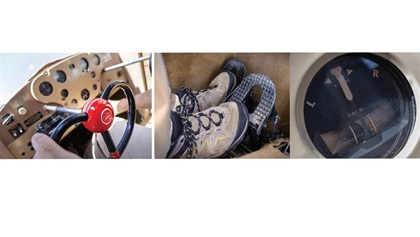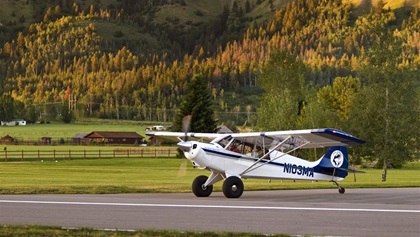Old is new
Primary training in a taildragger is not a step back

 Density altitude isn’t a factor below 1,800 feet msl. And my favorite: Tailwheel airplanes are inherently dangerous and too difficult for most pilots to fly. It is far too often assumed that taking initial flight training in a taildragger is not only dangerous but unnecessarily drags out training.
Density altitude isn’t a factor below 1,800 feet msl. And my favorite: Tailwheel airplanes are inherently dangerous and too difficult for most pilots to fly. It is far too often assumed that taking initial flight training in a taildragger is not only dangerous but unnecessarily drags out training.
It’s a good thing aviation didn’t know how supposedly dangerous training in taildraggers is because, for the first 50 years after the Wright brothers did their thing, virtually no one learned to fly in a tricycle-gear airplane. Nosewheel trainers didn’t become commonplace until the late 1950s, and even then it took a long time for the Piper J–3 Cub and Aeronca Champ to relinquish their holds on training as Cessna 152s and Piper Cherokees took over. Primary students in tailwheel airplanes didn’t know they were doing the impossible because they had nothing to compare it to. However, tailwheel students develop skills and perceptions tricycle-gear students don’t because nosewheel airplanes don’t need them as much.
The upside
Tailwheel aircraft include classics such as Piper Cubs as well as newer backcountry airplanes. Although they’re popular competitors in short-takeoff-and-landing competitions, they’re rarely used for primary instruction. When talking about flying a taildragger, the discussion always focuses on the differences in the way they handle on the ground. If we’re to believe the wags out there, a tailwheel airplane is so difficult to control that it will ground loop the instant it is untied. This obviously isn’t true—and focusing on the hazards of ground handling distracts from the many other ways flying tailwheel airplanes is beneficial to a student.
Modern trainers are designed specifically to be easy to fly and safe. In a tailwheel airplane, the consequences of lapses such as letting the turn coordinator ball wander or touching down crooked are noticeable right away. In effect, the tailwheel airplane does some of the instruction all by itself. In a nosewheel airplane, where the differences between right and wrong are subtle, the CFI has to push himself to teach the basics, because the airplane often will accommodate imprecise flying. Yes, nosewheel pilots will be safer if they’re taught to fly with precision. However, they may not know the difference until they find themselves in a demanding situation where the basics really count.
 Some of the benefits of doing primary training in a tailwheel trainer:
Some of the benefits of doing primary training in a tailwheel trainer:
Proper runway alignment on touchdown. If a tailwheel airplane is landed with its longitudinal axis aligned with the flight path and zero drift, there is no reason for the airplane to turn either direction (assuming no crosswind). So, the whole goal of landing a tailwheel airplane is center of gravity aligned with the flight path, no drift. If either of those isn’t part of the touch, the center of gravity will obey Isaac Newton’s First Law of Motion and regardless of where the nose is pointed, it will travel in a straight line and take the tailwheel with it. Land square with no drift, no sweat. Land crooked or drifting, lots of sweat. When tailwheel-trained pilots transition into other airplanes, tailwheel or nosewheel, they instinctively land in a square/no-drift condition.
Basic coordination. Tailwheel trainers almost always have more adverse yaw than modern nosewheel aircraft. This is because they are older designs, not because they sport a tailwheel. For that reason, when flying the approach, the pilot has to continually be aware of what the ball is doing during power and speed changes. This is especially true in the flare on landing. When the angle of attack is increasing and speed is falling off, in some aircraft, adverse yaw increases noticeably. This results in left/right nose movement with the slightest of aileron displacements. So, if maneuvering the aircraft over to centerline, while low and slow or battling turbulence, the right amount of rudder has to be part of the control equation. The proper use of rudder with aileron at all times becomes a subliminal act for tailwheel pilots.
 Visual perception. Because reuniting a tailwheel airplane with the runway properly aligned is so critical (alignment is important on takeoff too), tailwheel pilots have visual acuity hammered into them from day one. The guiding mantra is “You can’t fix what you can’t see,” so tailwheel CFIs are constantly making sure their students see exactly what the airplane is doing at all times, especially in the flare. In most tailwheel airplanes, as the nose comes up during the flare, the center of the runway disappears, forcing the pilot’s eyes to the sides of the runway. At that point, her eyes should be controlling the relationship of the nose to the horizon, the centerline, and the runway edges. Her ability to do that is what determines whether the rollout on the runway will be straight and calm or dramatic and crooked. The pilot is hypercritical of everything that is happening at that point and makes lots of small corrections before touchdown, so she doesn’t have to make them after touchdown. This increased visual perception helps when flying any airplane, not just taildraggers.
Visual perception. Because reuniting a tailwheel airplane with the runway properly aligned is so critical (alignment is important on takeoff too), tailwheel pilots have visual acuity hammered into them from day one. The guiding mantra is “You can’t fix what you can’t see,” so tailwheel CFIs are constantly making sure their students see exactly what the airplane is doing at all times, especially in the flare. In most tailwheel airplanes, as the nose comes up during the flare, the center of the runway disappears, forcing the pilot’s eyes to the sides of the runway. At that point, her eyes should be controlling the relationship of the nose to the horizon, the centerline, and the runway edges. Her ability to do that is what determines whether the rollout on the runway will be straight and calm or dramatic and crooked. The pilot is hypercritical of everything that is happening at that point and makes lots of small corrections before touchdown, so she doesn’t have to make them after touchdown. This increased visual perception helps when flying any airplane, not just taildraggers.
Visual scan. The net result of being introduced to the importance of visual references so early generates a pilot who spends more time eyeing the windshield than most. Not only does he look around more, but he’s pulling more details and information out of what he’s seeing. This is something that benefits pilots for as long as they are involved in aviation.
Transferrable skills. Tailwheel airplanes come in an incredible range of sizes, weights, and power, from ultralight to P–51 Mustang and beyond. The basic tailwheels skills apply to all of them, and when transferred to nosewheel airplanes, nothing is lost. Their pilots will be ahead of virtually any nosewheel airplane they are likely to fly. The same is not true in reverse, when going from nosewheel airplane to taildragger.
Educated butts. Sensing yaw/skid ball position via the butt-to-seat interface is just as applicable to nosewheel airplanes as tailwheel. However, because tailwheel airplanes tend to exist in a more traditional, grassroots environment, the concept of flying by the seat of your pants is more valued and part of the training regimen. This one attribute of basic training via tailwheel is reason enough to start in something like a Cub or Citabria. When this kind of awareness is built in from the beginning of flight training, the pilot can’t help but be more attuned to any airplane he flies.
Reaction time. Taildraggers vary tremendously in their runway personalities—almost insanely so. A Pitts Special, for instance, which might touch down at 80 mph, is not a Piper J–3 Cub with its 38-mph landing speed. However, regardless of type, in the process of learning to fly in a taildragger trainer, the student develops faster reaction times because he finds the sooner he corrects something on the runway, the easier it is to do.
The downside
There are no downsides to learning to fly in a tailwheel airplane. Nor is it any more difficult. The hardest part is finding a school or instructor who gives tailwheel instruction. There are more such tailwheel schools and instructors now than 10 years ago, but they’re still a rarity.
It’s not very important what type of airplane is being used, but what is important is that the instructor has enough CFI time in tailwheels that he’s not afraid of the airplane. You don’t want someone who is just building time. There’s a tendency for new tailwheel instructors to keep their students in the middle of the envelope because the instructors themselves aren’t comfortable at the edges of that envelope. This greatly limits the student’s understanding and experience. It takes time to develop a deep enough understanding of the airplane that the instructor is OK with letting his students wander around on the runway so they can experience the edge of the envelope. A critical part of the instructing game is to let the student go in a bad direction but not so far that the margins for recovery are gone.
Life doesn’t offer many guarantees, but here is one you can count on: You’ll never regret having started your flight training in a tailwheel airplane.
Besides bragging rights, you’ll be a better pilot for the experience.



